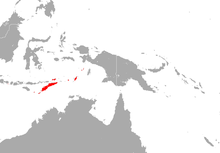|
Indonesian tomb bat
The Indonesian tomb bat (Taphozous achates) is a species of sac-winged bat in the family Emballonuridae.[2] It is found only in Indonesia. TaxonomyThe Indonesian tomb bat was described as a new species in 1915 by British mammalogist Oldfield Thomas. The holotype had been collected on the Indonesian island of Savu in 1896 by British naturalist Alfred Hart Everett.[3] The inspiration for the species name "achates" is the character of Achates from a Latin epic poem, The Aeneid. Oldfield Thomas frequently employed names from mythology and the Classics when naming new species of mammal.[4] DescriptionIn many characteristics, it is similar to the black-bearded tomb bat, though it can be differentiated by its conspicuously larger skull. Individuals have a forearm length of approximately 62 mm (2.4 in).[3] References
|
||||||||||||||||||||||||||||||||

